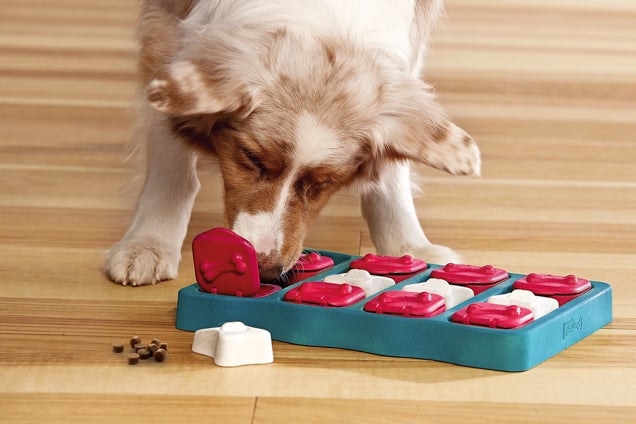Digging is one of those unwanted canine behaviors that doesn’t sound like a big deal until it is happening in your yard. However, even a small dog can make a big mess of a pretty garden by going to town digging all over the place. The problem is that digging is a very natural behavior that serves a purpose, so in order to stop the problem, you will need to figure out what your dog is getting out of it.
Contents
1. Diagnose the problem
Dogs dig for basically five reasons:
- Boredom
- Prey seeking
- Escape
- To cool off
- Attention
Dogs who are bored dig because it is fun. Some breeds of dogs, particularly the terriers, have been bred to enjoy digging. This type of digging is self-rewarding, so it is not going to stop unless you take steps to stop it. Dogs that dig for entertainment will do so at any time, with great abandon. They may have a favorite spot, or they may not.
Would-be wanderers are digging because they want to escape and explore. They may or may not be getting something out of the actual digging process, but they are mostly motivated to get to what is on the other side. Most of these dogs dig at the fence line when you are not home or at least not in the yard with them.
Prey-seeking dogs are digging for animals that live in the ground. This is a natural instinct that is fairly impossible to train out of a dog, so you probably need to work on getting rid of the pests instead. These dogs tend to dig little holes all over the place, although they may excavate larger holes if they smell a nest.
Attention-seeking dogs are digging as a means of interaction. As negative as the interaction may be (dog digs, human yells), at least you are paying attention to them. These are the dogs that may look at you deliberately, then start digging. Attention-seeking and entertainment digging often go together, though. These dogs think, “If you will pay attention, that’s great, but if you won’t, well, digging a hole is kind of fun, too.”
Dogs that are digging to stay cool need help. They may be getting dangerously overheated, and even if they are not, they may be seriously uncomfortable. Provide shade, water, and other cooling features for these dogs. The holes dug by hot, uncomfortable dogs tend to be near buildings or trees, and they tend to be wide, scratched-out spots that the dog lays in.
Now that we diagnosed the problem let’s find out what we can do about it.
2. Provide More Stimulation

Dogs that are bored, attention-seeking, prey-seeking, or looking to escape can all use more stimulation. They are digging to fill a physical or mental need that is not being met. A tired dog is a dog that is much less likely to dig.
All of the other things on this list are unlikely to work without addressing the root cause, which is a dog whose needs for mental and physical stimulation are not being met.
All dogs should get at least 30 minutes of exercise a day. Young, athletic dogs may need more. The type of exercise should be geared to their size and physical fitness level, but it should be more strenuous than a walk. Jogging, chasing a toy, playing with other dogs, or taking a long hike are examples of good types of exercise.
Mental stimulation is also often overlooked. Dogs spend a lot of their time alone with nothing to do. Most dogs spend a significant portion of this time sleeping, but that still leaves periods of boredom. If you provide things for them to do when they are alone and bored, they won’t be as likely to dig in your rose bushes. Mental stimulation can be provided in a lot of simple ways:
- Put their meals in a puzzle toy rather than a dish, and leave it for the dog when you go out
- Do a short training session before you leave (teach them a trick during this time!)
- Scatter kibble on a floor or outdoor surface for your dog to hunt down
- Hide treats around the yard for your dog to find
- Leave safe, desirable chewing items available
There are lots of other things that can be done to keep your dog’s brain working, which doesn’t leave as much time for thinking about and finding mischief.
3. Supervise or Remove Access
While you are working on your dog’s digging problem, you will need to remove access to the problem area when you cannot supervise. Dogs live in the moment and they cannot connect their behavior at one time (when they were digging) to your reaction at another (when you find the hole). If you don’t catch them in the act, it is too late to effectively reprimand them.
If it is practical, you may just choose to remove access entirely, at least when you are not there. If your dog digs while you are gone and you don’t mind that in their kennel run but you can’t tolerate it in your flowers, maybe they should just stay indoors or in their kennel run while you are gone. A low barrier can be effective in some cases because digging is not as fun or effective when there is a wall in the way.
To truly deal with the problem, do not let your dog be anywhere that he or she is not allowed to dig when your eyes are not on them. After they are reliably not trying to dig when you are watching, you can graduate to doing other things with them in the same space. Do not leave them alone in the area until you are certain their habits have changed.
4. Offer an Alternative
There are a number of alternatives to the digging behavior that your dog is doing, depending on the reason they are doing it. The simplest one is probably dogs that are seeking to cool off–just provide them with somewhere nicer to be. They might need more shade, or perhaps they could enjoy a wading pool of water instead. If your dog is digging because he or she is hot, this is a potentially hazardous situation that needs resolving. Make sure that your dog has plenty of water and shade while you work on the issue.
Dogs who dig for entertainment or because they are bored can often be entranced by a digging area of their own. This can be a piece of the yard, a wading pool full of dirt, or a child’s sandbox. Burying the dog’s toys in this area along with a few treats will make it more attractive. If you do choose to create a digging box for your dog, make sure to demarcate it clearly, using boards, bricks, or other barriers. Your dog cannot be expected to know that the limits of their digging area are this side of your prized petunias, not the other side, unless you have clearly marked it.
Attention-seeking dogs should be offered an alternative way to get your attention. At first, this might simply be you calling them when you think they are about to dig and rewarding them for coming to you. Once they come to you reliably, you can start asking them to do something, such as fetch a toy. They will learn that fetching a toy gets them playtime with you, and digging gets them nothing (or a time-out).
5. Use a Repellent
If your dog hates a certain smell or scent, considering using it to repel them from the digging area. However, there is no universal repellent for dogs. Just like people, some dogs are repelled from scents that others find attractive. If you do try using a repellent, don’t stop after the first one doesn’t work. There are commercial repellents for dogs in a variety of brands, and one type may work on your dog where another doesn’t.
There are also homemade options for repelling your dog from an area, such as citrus scents or the presence of their own feces. Be cautious when using a repellent that you do not know the effect of, though. Some dogs find their feces entrancing and citrus to be a perfume. The same applies to filling the holes with water–while this may discourage some dogs, it will encourage others. The effect will also not be likely to last beyond the period of time that the water remains in the hole.
6. Catch Them In The Act
The only time that you can effectively change a dog’s behavior is when you catch them in the act. If you are present when the dog starts to dig, you can tell them “No digging!” or “Leave it!” as they make the first paw swipe. If they stop digging, be sure to reward them and offer an alternative behavior. This could be taking them to their own digging box, playing a game with them, or giving them a puzzle toy to entertain themselves with.
For some dogs, a time-out is effective. This is 30 seconds to a minute of isolation in a boring room, immediately upon catching the dog in the act of digging. A time-out could be used when the dog does not respond to the warning you gave, as well. However, this will not be effective on all dogs.
Harsh Punishments Will Not Help

Harsh punishments include anything that scares or hurts your dog. What scares your dog depends on their personality–some dogs take things in stride that terrify others. It is up to you to know where your dog’s fears lie. Punishments that are scary or painful often backfire by causing problems that are associated with fear. Then, instead of a dog that digs, you have a dog with anxiety or other issues.
The other reason that harsh punishments do not work is that they stop the behavior rather than training an alternative behavior. Stopping the behavior does not result in the dog learning to do something else. Dogs don’t have the greatest amount of impulse control, so if all they know is that digging sometimes leads to punishment but not digging is boring as heck, they are going to decide to dig at least occasionally.
Get Help If You Are In Over Your Head
Behaviorists and trainers are there to help if you are at your wits’ end on how to stop your dog from digging. A trainer or behaviorist can also look at the situation from the outside, which sometimes allows them to see triggers or causes that you may have overlooked.
If you do choose to hire a trainer, choose a positive reinforcement-based trainer. Be your dog’s advocate, as well–he doesn’t have anyone else. This means that if a trainer ever tells you to do something to your dog that you are not comfortable with, either ask them to explain or don’t do it. A good trainer will respect your wishes.







